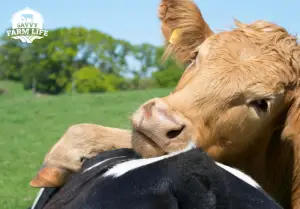How Cows Show Affection
If you have spent any amount of measurable time with a herd of cows, you know that they are intelligent, complex beings. Cows form strong bonds and show affection through a variety of methods.
So, how do cows show affection? Cows are naturally affectionate animals, and they show affection by:
- Developing strong bonds and friendships
- Grooming
- Following their friends
- Mooing
- Approaching humans to be pet
- Cuddling and other physical contact
- Lying down next to one another and humans
- Eating out of the hand
- Playing
- Standing head-to-head (especially during courtship)
To properly care for cattle, it is important that you understand the ways that they communicate. Accurately assessing a cow’s feelings will allow you to limit the stress they are experiencing, thus increasing productivity. A cow is a wondrously friendly being, and ensuring that she has a fulfilling social life will reap rewards in the long run. Read on to learn more about how a cow may show affection.
Ways That Cows Can Show Affection
Building Bonds 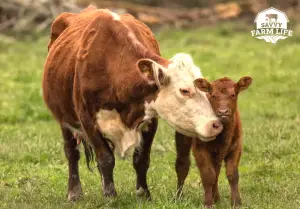
Having such a complex social structure, cows are able to form deep bonds with one another. Much has been studied and documented to this regard, as happier cows tend to lead to more productive cattle, particularly within the dairy industry. Moving cows in and out of herds has been proven to increase the stress level within a group, and care should be taken to keep herds together when possible.
Cows have been known to have “best friends”, that seem to be linked to age and seniority which adds credence to the idea that cows form the closest relationships with those that they grow up with. Cow “friends” will graze together, sleep together, and even visit the watering trough together. They enjoy one another’s company and feel safe together. While this is most commonly seen within a group of cows, they have also been known to develop these close bonds with other species as well, including humans.
Friendships are not the only close relationships that cows have. You will be hard pressed to find a deeper bond than that between a cow and her calf. Cows remain very close to their calves throughout their lives. Cows will continue to nurse a calf for up to three years if allowed, and they visibly and audibly mourn the loss of their young when their calves are removed from them. Cows will continue to care for and show preference to their calves even after they have had subsequent births. It is clear that cows are both emotional and sentimental beings.
And so one of the clearest ways that cows can show affection is through the ability to form deep, long-lasting bonds with one another and with their handlers.
Following One Another 
If you notice your cow following you around when you are working outside, chances are your cow likes hanging out with you. After all, one would not attempt to stay close to someone unless they enjoyed being with that person.
Of course, the reasonable assumption can be made that your cow may just be following you because they expect you to feed them. While this is often true, a cow would not follow a person – even for treats – unless there was some measure of trust and respect within the relationship. So even if your cow is following you in hopes of a snack, you can assume that she trusts you and likes spending time with you.
Grooming 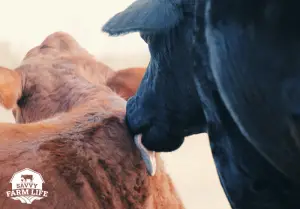
Allogrooming is a term used to refer to the grooming of one another within the same species. While this occurs regularly within a herd of cattle, cows have also been known to groom others outside of their species to show affection as well. If you do a search online you are likely to find videos of cows grooming one another, their livestock friends, and even their handlers.
Cows groom in a specific way to show affection – they lick on another around the head and the neck to form bonds and connect with one another. It is believed that the focus on the head and neck is a way to groom one another in areas that a cow cannot reach herself. In this way, they are caring for one another.
Grooming amongst a cattle herd is much more complex than one might think. US and Chilean scientists have studied the intricacies of the behavior and have documented their findings, including the observations that older cows groom more often than younger cows (revealing them to be the peacemakers and matriarchs within a herd), cows spend most of their time grooming their closest friends and offspring (showing that grooming is an act meant to show affection within a relationship), and cows will often groom another right after they have been groomed themselves (showing the importance of reciprocity in the behavior).
Interestingly, it has also been observed that cows who lick others they are not close with tend to not get groomed very often themselves – showing that close bonds are important to cows and there is a lot more to developing these relationships than the simple act of licking one another.
Mooing 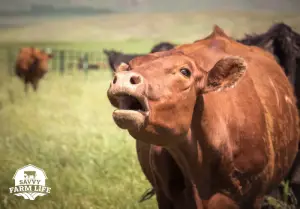
Despite the emphasis on the cattle industry, little is known about cow vocalizations. It is clear, however, that a cow will mourn the loss of another through mooing, and cows will moo to connect with one another when they are apart. If you head outside and your cow comes to the fence and moos for you, it may be a sign that she is happy to see you. Of course, it may also be a sign that she is hungry. The more time you spend with your cows, the easier it will be to assign meaning to their various vocalizations.
Requesting Scratches
Cows love scratches and pets, which may feel like a form of grooming to them, and will often request these from the humans around them. If your cow trusts you and enjoys being with you, you will often find her walking up to you and offering her head or neck for a pet.
Cuddling
Just as a cow will often visit a trusted human for scratches, she may also show affection by “cuddling”. The way a cow cuddles will look differently than other pets; cows have been known to press gently or nudge against a human for physical contact. While this is particularly cute with calves and smaller breeds, cows can reach well over 1,000 pounds and care must be taken to maintain boundaries with them for safety reasons.
Requesting Belly Rubs
Just as a cow will encourage pets, scratches, and cuddles with those closest to them, a cow may also ask you for a belly rub. Cows enjoy belly rubs just as much as do dogs and pigs, and are not shy about asking for them from their favorite human handlers. It is not unheard of for a cow to lie down next to a trusted human who is sitting on the ground, lay her head in the person’s lap, and expose her belly. They will often close their eyes and even smile as they get their bellies scratched.
Eating From Your Hand 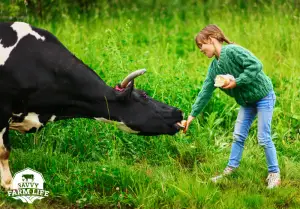
Cattle are prey animals, and like all prey animals, they are suspicious of strangers and those they do not trust. If you are able to get a cow to eat out of your hand, you can assume that she likes you, trusts you, and believes she is safe around you.
Playing
While adult cows are not as playful as many other species, you will often find a carefree cow frolicking and playing when she is happy. She may even play with toys or roll a ball with you. A cow that is playing with you is a cow who feels safe with you and is happy and confident.
Standing Head-to-Head 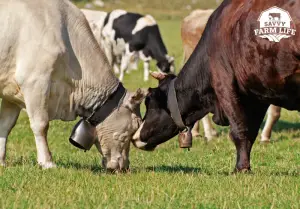
This sign of affection is reserved for courtship, but is worth a mention nonetheless. When a bull would like the attention of a heifer or cow, he will approach her and will attempt to “cuddle” with her nose-to-nose. He may also walk around her to lay his head on her back. While this seems like a sweet display of affection, it is really a test to see whether or not the female is receptive. Nonetheless, it is a sign of affection in courtship and a way for the couple to bond before procreating.
Cow-Human Affection
If you are hoping to see signs of affection from your cow, you must first spend time with her. Cows are clearly relational beings, and one must earn their trust before expecting to be showered with affection. If you offer respect and prove yourself to be trustworthy, you will likely find yourself with a couple of cows in your pocket before long.
The best friend of a cow will usually be another cow, but there are many documented stories of cows forming special relationships with goats, sheep, horses, dogs, and even humans. Like all animals, cows are individuals and each cow will have his own unique personality. Some cows may find it easier to bond with their handlers than others. Some cows are particularly friendly, while others are more shy.

